Decision Making Capability on Knowledge Based Management Information Systems: Perspective from Information Technology and Organizational Commitment
DOI:
https://doi.org/10.38035/gijtm.v3i1.332Keywords:
Liquidity, Earnings Management, Independent Commissioner, Executive Compensation, Tax AggressivenessAbstract
This study aims to analyze the influence of Information Technology and Organizational Commitment to Knowledge-based Management Information System and its implication to decision making capability. The target population of this study is comprised of 500 managers and staff members working in construction companies located in the West Java Province. Due to the utilization of SEM-PLS analysis in this study, can utilize the rule of thumb to determine the sample size, which is 20 times the number of parameters present in the research model. Within this study, there are a total of 5 parameters, resulting in a selected sample of 100 managers and staff members. The results of this study found that liquidity, earnings management and independent komisais affect tax aggressiveness, while executive compensation does not affect the aggressiveness of taxes. Based on total adjusted R-Square results prove that liquidity, earnings management, independent commissionist, and executive compensation only affect 26%, while 74% is influenced by other variable not tested in this research.
References
Al-Hashemy, R. H. H. (2021). Conceptual framework for the role of information technology in developing a knowledge management system. 1st Babylon International Conference on Information Technology and Science 2021, BICITS 2021. https://doi.org/10.1109/BICITS51482.2021.9509928
Anggraeni, A. F. (2021). How to improve the quality of accounting information system in digital era (an empirical study of state-owned enterprises in Indonesia). Economic Annals-??I. https://doi.org/10.21003/ea.v194-15
Balasubramanian, P., Nochur, K., Henderson, J. C., & Kwan, M. M. (1999). Managing process knowledge for decision support. Decision Support Systems, 27(1), 145–162. https://doi.org/https://doi.org/10.1016/S0167-9236(99)00041-X
Belbaly Aissa, N., Gur?u, C., Psychogios, A., & Somsing, A. (2022). Transactional memory systems in virtual teams: Communication antecedents and the impact of TMS components on creative processes and outcomes. Technological Forecasting and Social Change, 174, 121235. https://doi.org/https://doi.org/10.1016/j.techfore.2021.121235
Bergeron, E., Audy, J.-F., & Forget, P. (2023). Visibility Performance Assessment: Simulation of a Digital Shadow in a Port. Journal of Marine Science and Engineering, 11(5), 927. https://doi.org/https://doi.org/10.3390/jmse11050927
Bothma, M., & Mostert, L. (2023). Adopting the technology acceptance model: A Namibian perspective. SA Journal of Information Management. https://doi.org/10.4102/sajim.v25i1.1624
Bret Swan, by R., & Patrick Koelling Tonya Smith-Jackson David Tegarden, C. P. (2007). The Effects of Business Process Management Cognitive Resources and Individual Cognitive Differences on Outcomes of User Comprehension.
Bumblis, J. R., & King, P. (2007). Software agent technology in e-business: Impact and implications to information technology and information systems [Argosy University/Twin Cities]. In ProQuest Dissertations and Theses. https://www.proquest.com/dissertations-theses/software-agent-technology-e-business-impact/docview/304700809/se-2?accountid=49910
Deja, M. (2019). Information and knowledge management in higher education institutions: the Polish case. Online Information Review, 43(7), 1209–1227. https://doi.org/10.1108/OIR-03-2018-0085
Duggan, E. W., & Reichgelt, H. J. P. M. (2006). Measuring information systems delivery quality. In Measuring Information Systems Delivery Quality. https://doi.org/10.4018/978-1-59140-857-4
Ellenbecker, C. H., & Cushman, M. (2012). Home healthcare nurse retention and patient outcome model: Discussion and model development. Journal of Advanced Nursing. https://doi.org/10.1111/j.1365-2648.2011.05889.x
Galetsi, P., Katsaliaki, K., & Kumar, S. (2019). Values, challenges and future directions of big data analytics in healthcare: A systematic review. Social Science & Medicine, 241, 112533. https://doi.org/https://doi.org/10.1016/j.socscimed.2019.112533
Ghasemi, M., Shafeiepour, V., Aslani, M., & Barvayeh, E. (2011). The impact of information technology (it) on modern accounting systems. Procedia - Social and Behavioral Sciences. https://doi.org/10.1016/j.sbspro.2011.11.023
Gorgun, M. G., Polat, S., & Asan, U. (2022). Vertical Integration Decision Making in Information Technology Management. Information (Switzerland). https://doi.org/10.3390/info13070341
Halal, W. E. (1984). Strategic management: The state-of-the-art and beyond. Technological Forecasting and Social Change, 25(3), 239–261. https://doi.org/https://doi.org/10.1016/0040-1625(84)90004-0
Hnatchuk, Y., Hovorushchenko, T., Shteinbrekher, D., Boyarchuk, A., & Kysil, T. (2023). Medical information technology for decision-making taking into account the norms of civil law. International Journal on Information Technologies and Security. https://doi.org/10.59035/yvmt7964
Jarah, B. A. F., Zaqeeba, N., Al-Jarrah, M. F. M., Badarin, A. M. Al, & Almatarneh, Z. (2023). The Mediating Effect of the Internal Control System on the Relationship between the Accounting Information System and Employee Performance in Jordan Islamic Banks. Economies, 11(3), 77. https://doi.org/https://doi.org/10.3390/economies11030077
Keng-Soon, C., Choo Yen-San, W., Pui-Yee, Y., Hong-Leong, C., & Teh Shwu-Shing, J. (2019). AN ADOPTION OF FINTECH SERVICE IN MALAYSIA. South East Asia Journal of Contemporary Business, Economics and Law, 18(5).
Kuo, R. Z., & Lee, G. G. (2009). KMS adoption: The effects of information quality. Management Decision. https://doi.org/10.1108/00251740911004727
Laihonen, H., & Saranto, K. (2022). Knowledge Management Competencies in Health and Social Care. In European Conference on Knowledge Management (Vol. 2, pp. 715–722, R32). Academic Conferences International Limited. https://www.proquest.com/conference-papers-proceedings/knowledge-management-competencies-health-social/docview/2734336344/se-2?accountid=49910
Lee, C.-H., & Zhao, X. (2024). Data Collection, data mining and transfer of learning based on customer temperament-centered complaint handling system and one-of-a-kind complaint handling dataset. Advanced Engineering Informatics, 60, 102520. https://doi.org/https://doi.org/10.1016/j.aei.2024.102520
Mariano, S., & Awazu, Y. (2016). Artifacts in knowledge management research: a systematic literature review and future research directions. In Journal of Knowledge Management. https://doi.org/10.1108/JKM-05-2016-0199
Memon, K. R., Ghani, B., Hyder, S. I., Han, H., Zada, M., Ariza-Montes, A., & Arraño-Muñoz, M. (2022). Management of knowledge and competence through human resource information system—A structured review. Frontiers in Psychology. https://doi.org/10.3389/fpsyg.2022.944276
Meredith, K., Blake, J., Baxter, P., & Kerr, D. (2020). Drivers of and barriers to decision support technology use by financial report auditors. Decision Support Systems, 139, 113402. https://doi.org/https://doi.org/10.1016/j.dss.2020.113402
Mohamed, M. S., Ribière, V. M., O’Sullivan, K. J., & Mohamed, M. A. (2008). The re?structuring of the information technology infrastructure library (ITIL) implementation using knowledge management framework. VINE, 38(3), 315–333. https://doi.org/10.1108/03055720810904835
Mohmed Al-Sabaawi, M. Y., & Alyouzbaky, B. A. (2022). The Impact of Information Technology Infrastructure Flexibility and Behavioral Biases on Investment Decision Making. International Journal of Enterprise Information Systems. https://doi.org/10.4018/IJEIS.313050
Nevo, D., & Wand, Y. (2005). Organizational memory information systems: a transactive memory approach. Decision Support Systems, 39(4), 549–562. https://doi.org/https://doi.org/10.1016/j.dss.2004.03.002
Nitzl, C., Hilgers, D., Hirsch, B., & Lindermüller, D. (2020). The Influence of the Organizational Structure, Environment, and Resource Provision on the Use of Accrual Accounting in Municipalities. Schmalenbach Business Review. https://doi.org/10.1007/s41464-020-00086-y
Noori, B., & Hossein Salimi, M. (2005). A decision?support system for business?to?business marketing. Journal of Business & Industrial Marketing, 20(4/5), 226–236. https://doi.org/10.1108/08858620510603909
Pan, Y., Xu, Y. (Calvin), Wang, X., Zhang, C., Ling, H., & Lin, J. (2015). Integrating social networking support for dyadic knowledge exchange: A study in a virtual community of practice. Information & Management, 52(1), 61–70. https://doi.org/https://doi.org/10.1016/j.im.2014.10.001
Rahman, H. U., Raza, M., Afsar, P., Khan, M., Iqbal, N., & Khan, H. U. (2021). Making the Sourcing Decision of Software Maintenance and Information Technology. IEEE Access. https://doi.org/10.1109/ACCESS.2021.3051023
Shahidi, S., Abdolvand, N., & Rajaee Harandi, S. (2015). Assessing The Organizational Readiness For Implementing Knowledge Management In Organizations. International Journal of Information Technology Convergence and Services. https://doi.org/10.5121/ijitcs.2015.5602
Tan, X., & Siau, K. (2006). Understanding information systems developers’ modeling method continuance: A theoretical model and an empirical test [The University of Nebraska - Lincoln]. In ProQuest Dissertations and Theses. https://www.proquest.com/dissertations-theses/understanding-information-systems-developers/docview/305274623/se-2?accountid=49910
Thamhain, H. J. (2004). PROJECT MANAGEMENT, INFORMATION TECHNOLOGY, AND INFORMATION SYSTEMS: EMJ. Engineering Management Journal, 16(1), 1–2. https://www.proquest.com/scholarly-journals/project-management-information-technology-systems/docview/208967617/se-2?accountid=49910
Torres, M. F., & Seteroff, S. S. (2009). The effect of mergers and acquisitions in the information technology organizational structures [University of Phoenix]. In ProQuest Dissertations and Theses. https://www.proquest.com/dissertations-theses/effect-mergers-acquisitions-information/docview/907106588/se-2?accountid=49910
Wang, G., Niu, Y., Mansor, Z. D., Leong, Y. C., & Yan, Z. (2024). Unlocking digital potential: Exploring the drivers of employee dynamic capability on employee digital performance in Chinese SMEs-moderation effect of competitive climate. Heliyon. https://doi.org/10.1016/j.heliyon.2024.e25583
Wongsim, M., & Gao, J. (2011). Exploring Information Quality in Accounting Information Systems Adoption. Communications of the IBIMA, 1–12. https://doi.org/10.5171/2011.683574
Zuleha, A. (2022). The Effect of Information Technology, Single Sign on Information System, Knowledge Management on Business Performance (Literature Review Executive Support System for Business). Dinasti International Journal of Digital Business Management.
Downloads
Published
How to Cite
Issue
Section
License
Copyright (c) 2025 Deden Komar Priatna, R. Jusdijachlan, Susan Ridwan, Anne Lasminingrat, Herni Suryani

This work is licensed under a Creative Commons Attribution 4.0 International License.
Copyright :
Authors who publish their manuscripts in this journal agree to the following conditions:
- Copyright in each article belongs to the author.
- The author acknowledges that the Greenation International Journal of Tourism and Management (GIJTM) has the right to be the first to publish under a Creative Commons Attribution 4.0 International license (Attribution 4.0 International CC BY 4.0).
- Authors can submit articles separately, arrange the non-exclusive distribution of manuscripts that have been published in this journal to other versions (for example, sent to the author's institutional repository, publication in a book, etc.), by acknowledging that the manuscript has been published for the first time at GIJTM.


























